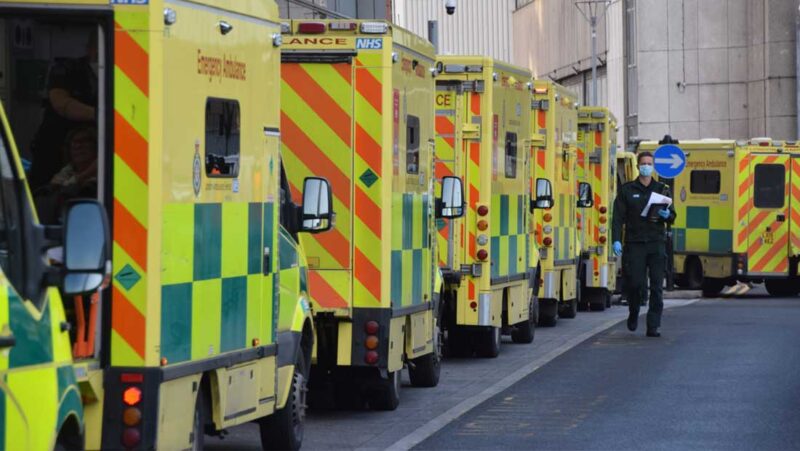The coronavirus outbreak has significantly changed how healthcare is delivered in the NHS. This has driven a need for rapid transformation of services at a time of immense pressure, which has been a major personal and professional challenge within organisations.
Within County Durham and Darlington NHS Foundation Trust (CDDFT), the pharmacy team at Darlington Memorial Hospital started to look at transforming the clinical service as a result of working differently during the pandemic. As a rapid response to the pandemic, the pharmacy clinical services were restructured to enable flexibility to respond to the challenges that the first few days and weeks of COVID presented. This involved the clinical pharmacists and technicians forming teams, which enabled them to respond to surges in demand rapidly and effectively.
Although this response was effective in the early stages of the pandemic where the clinical landscape was changing daily, it was not sustainable. It involved a ‘command and control’ approach that was suitable for a crisis but was not a long-term solution. The consensus was that people were amazed at the progress that could be made in a matter of weeks. Ideas and changes that historically would have taken years to implement were actioned in days or even hours.
The vision for the ideal clinical pharmacy service is to develop a service that works flexibly across the trust to ensure that patients receive the high quality pharmaceutical care when and where they need it.
The senior pharmacist group identified the need to learn from their experiences and make the most of the opportunity that the disruption the COVID pandemic had caused, identifying the need for clinical pharmacy services to adapt to the post-COVID healthcare landscape.
The whole hospital trust was undergoing a reset of clinical services to enable provision of healthcare in a world with COVID. The pharmacy needed to not only respond to these changes to ensure that their services aligned, but also identify any gaps or opportunities that would benefit from an increased pharmacy service.
Creating a vision
The senior pharmacists initially agreed upon a vision for the ideal clinical pharmacy service: to develop a service that works flexibly across the trust to ensure that patients receive the high quality pharmaceutical care when and where they need it.
The vision focuses on better utilisation of staff to enable technicians and junior pharmacists to manage wards with senior pharmacist oversight. This would enable senior pharmacists to focus on more complex medicines optimisation activities across the spectrum of secondary care and into primary care, making better use of their more advanced skills and knowledge. It also considered training and development for all staff grades to empower the development of roles and to enhance skill mix within the pharmacy team. Key enablers included near patient clinical services to enhance patient flow throughout the hospital and to ensure high quality care was provided to patients.
It is clear from the above vision that a flexible pharmacy workforce is essential for the future. It needs to meet the demands of patients, the trust and the wider NHS, whilst also providing pharmacy staff with a fulfilling role that enables development and empowerment.
Learning from the crisis
The senior pharmacists at CDDFT established a project team who developed a stepwise approach to understand the current and future demands at a strategic level. They worked to understand the services’ strengths, weaknesses, opportunities and threats, in order to enable a review of the current environment and discuss the vision for the ideal future clinical pharmacy service.
Following the crisis phase of the COVID-19 pandemic the senior pharmacy team at Darlington Memorial Hospital reviewed the situation to learn from their experiences and determine the next stages to transition into the second phase of the NHS response.
Strengths
The team identified that the command and control structure that was necessary to manage the initial phase of the pandemic had strengths, including clear communication pathways, support for the wider trusts’ clinical response, and prioritisation of pharmacy activity leading to a clear positive benefit for patients and other stakeholders. In addition:
- Specialist Pharmacists involvement in care pathways
- Positive medic/consultant support
- Pharmacy team visibility on wards
- Seeing more patients via front loading admissions
- Structured early years pharmacist training and development.
Weaknesses
The COVID-19 pandemic also revealed some long standing weaknesses of the pharmacy team, These included a flattened clinical structure that did not fully utilise senior pharmacy clinicians, an insufficient IT infrastructure, inadequate access to information via IT resources, and leadership structures that were not fully aligned with services. In addition:
- Differentiation of roles (such as senior / junior pharmacists)
- Lack of IT resources
- Pharmacist cove not available on all wards
- Pharmacy service inpatient focused
- Poor utilisation of technicians and the need to optimise and give more responsibility
- Poor intranet layout to access clinical information
- Insufficient dispensary management
- Pharmacy leadership structure not aligned with services
- Insufficient operational site leadership and support.
Opportunities
In the second phase of the pandemic response there were opportunities to enhance the care and services provided by the pharmacy team. In particular, the medical teams acknowledged the important role of pharmacy within the MDT during the first phase of the COVID response. The pharmacy service already has a number of specialist pharmacist posts but the trust identified the importance of high quality medicines management and pharmacy input into services. Key to releasing the potential of pharmacy is to ensure the optimal use of the skills of the whole pharmacy team, high quality development support for all, and robust but flexible patient centred pharmaceutical care pathways. In addition:
- Expanding specialist services post-COVID
- Case loading/referrals for senior review
- Joint working with colleagues
- All wards to use IT based pharmacist handover
- Develop discharge teams
- Decrease pharmacist time in dispensary
- Development of junior pharmacists’ rotations, including portfolio / support
- Development of ward teams (pharmacists, technicians, ATOs, IT)
- Increase weekend and seven-day working
- Senior pharmacist development.
Threats
Threats to developing pharmacy in the second phase of COVID were highlighted as the usual structural, recruitment and funding issues, coupled with the threat of a second COVID spike and any restructuring of the trust or the wider NHS:
- Retaining staff
- Staff sickness
- Funding
- Continuity and succession planning
- Future plans, such as the structure of the trust
- Second spike of COVID.
Senior pharmacists were also asked to complete their own personal programmes of activity, describing their current work plans. This highlighted the need to utilise the current senior workforce more effectively to optimise their physical presence on the ward, empower more junior staff to provide care by increasing their clinical supervision, and enable development pathways following the RPS foundation and advanced level frameworks. This would allow senior management to have an overview of current and future activity of senior pharmacists, and to support development, job planning and enhancement of the clinical workforce.
A review of current registered pharmacy staff was undertaken to highlight vacancies and to enable future workforce planning. This enabled an audit of the current available workforce, future planned workforce changes including recruitment, and any gaps in the workforce requirements. Gaps identified in the workforce needed to support services post-COVID were fed back into the wider trust wide reset process. Business cases were then developed and aligned with the wider pathway changes within the organisation.
Following this process of review and analysis, recurrent themes were highlighted and feedback from key stakeholders was sought. Subsequently, four work streams were established:
- Review of medicines management on the wards, improved communication, and a more holistic and flexible approach to patient care
- Consistent support and training of rotational pharmacist staff
- Improvement of pharmacy information resources (intranet page and hardware)
- Develop innovative pathways and models of care.
Working groups were formed with a member of the senior management team allocated to lead each work stream. Action plans were developed within each workstream, shared within the wider department and the other acute site within the Trust. This was fed into the wider trust reset strategy to ensure that pharmacy has a strong voice and role in the recovery phase of the COVID crisis. Senior pharmacists’ work plans were reviewed, and this holistic consideration of the roles and priorities of all staff has enabled better alignment of the future workforce provision. In conjunction with the gap analysis of the current workforce, a plan for future workforce development within the pharmacy team at CDDFT was developed.
Why it worked
Empowering junior pharmacists and technicians
The CDDFT pharmacy vision for post-COVID recovery focuses on utilising our staff more effectively to enhance patient care. Empowering junior pharmacists and technicians to take responsibility for the care of patients and make decisions, whilst providing support with more senior colleagues, had significant benefits.
It both enhanced the clinical skills and behaviours of the junior pharmacists and technical workforce by promoting their autonomy, as well as providing more oversight from senior pharmacists through robust clinical supervision structures. This also allowed the more senior pharmacists the time and opportunity to develop advanced clinical roles looking after more pharmaceutically complex patients.
The key to this was a simple change to the day-to-day structure of clinical pharmacy services to enable technicians and junior pharmacists to manage wards with senior pharmacist oversight built in. This enabled senior pharmacy staff to support the wider strategy of the hospital trust in a post-COVID world.
Training and development
Reshaping the clinical pharmacy services, underpinned by robust technical pharmacy support, has provided an opportunity to expand pharmacy services into the new pathways developed by the trust in response to delivering healthcare in the second phase of the COVID response. Key to this is considering training and development for all staff grades to be able to enhance our skill mix and develop roles within the pharmacy team. This includes simple solutions such as increasing near-patient dispensing to maintain patient flow throughout the hospital and to ensure we provide a high quality clinical service.
It will also include more innovative solutions such as pharmacists working as practitioners in same-day emergency care pathways, supporting frailty pathways, delivering virtual outpatient clinics or working across the interface to support patients to manage their medicines in the new healthcare environment.
Embracing change
During the COVID-19 virus pandemic CDDFT pharmacy teams have identified the need to work differently on the wards and within the pharmacy department, adapting the service rapidly to facilitate current changes in practice. Senior pharmacists have worked together to help develop the future of the pharmacy service, allowing them to reflect on their current practice and appreciate each other’s commitments and vision.
During the COVID crisis we have had to work differently; the scale and pace of the change necessitated novel ways of working. The key to the recovery is embracing these changes, learning from the experience, and implementing systems that will allow the pharmacy service to respond to the demands of the future.
The opinions expressed in this article are those of the author. They do not purport to reflect the opinions or views of the UKCPA or its members. We encourage readers to follow links and references to primary research papers and guidance.
Competing interest statement:
The author declares: no support from any organisation for the submitted work; no financial relationships with any organisations that might have an interest in the submitted work in the previous three years; no other relationships or activities that could appear to have influenced the submitted work.




